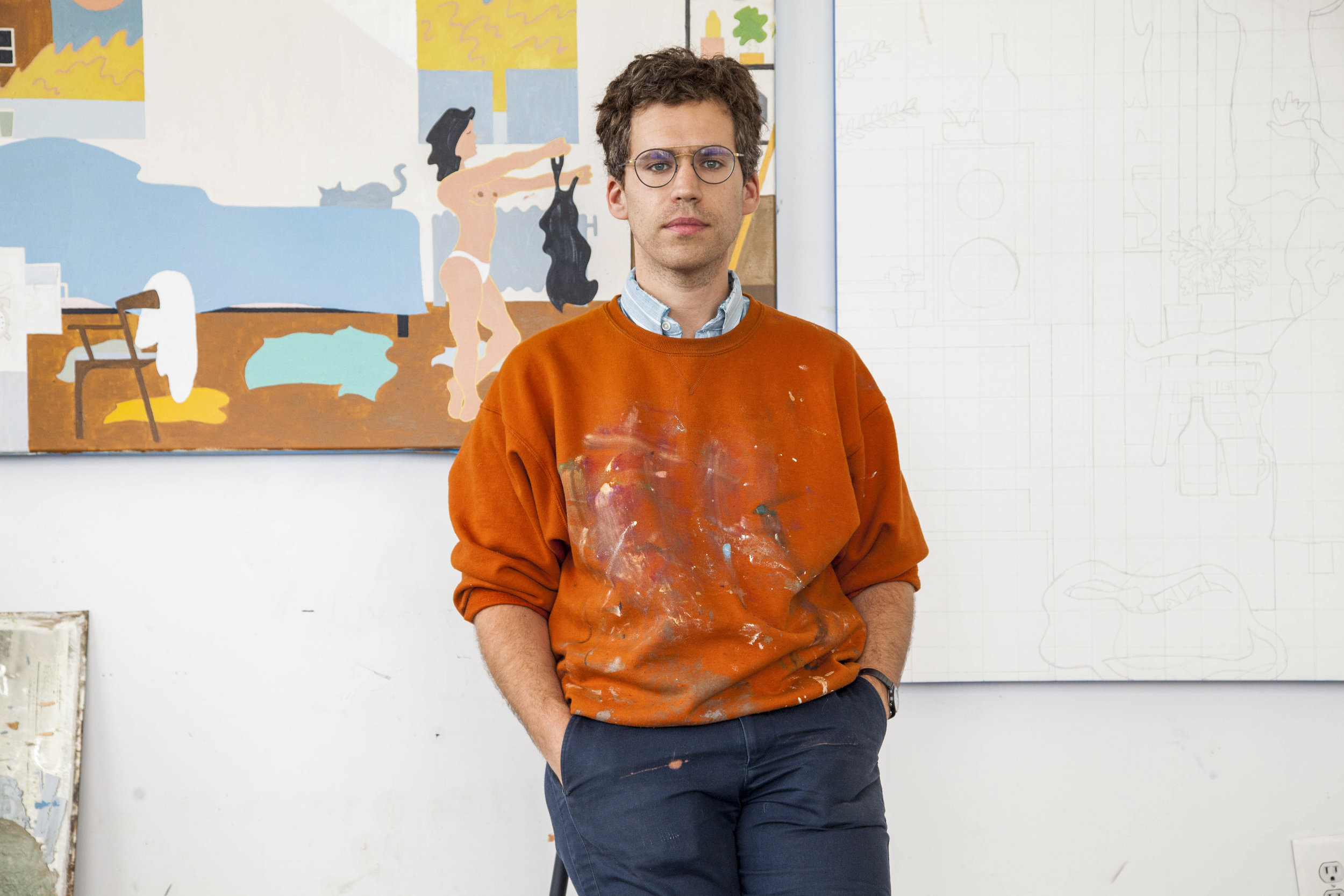
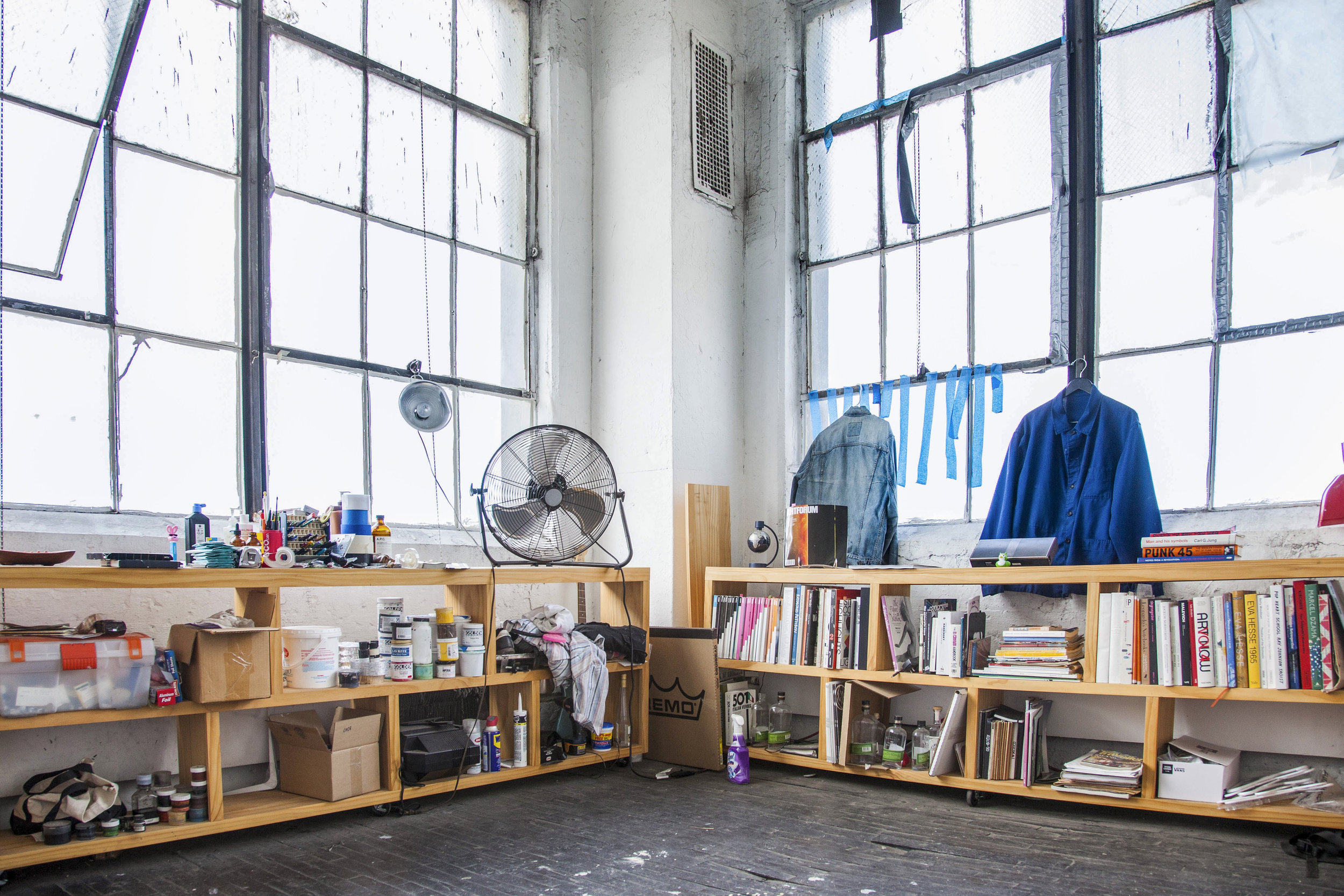
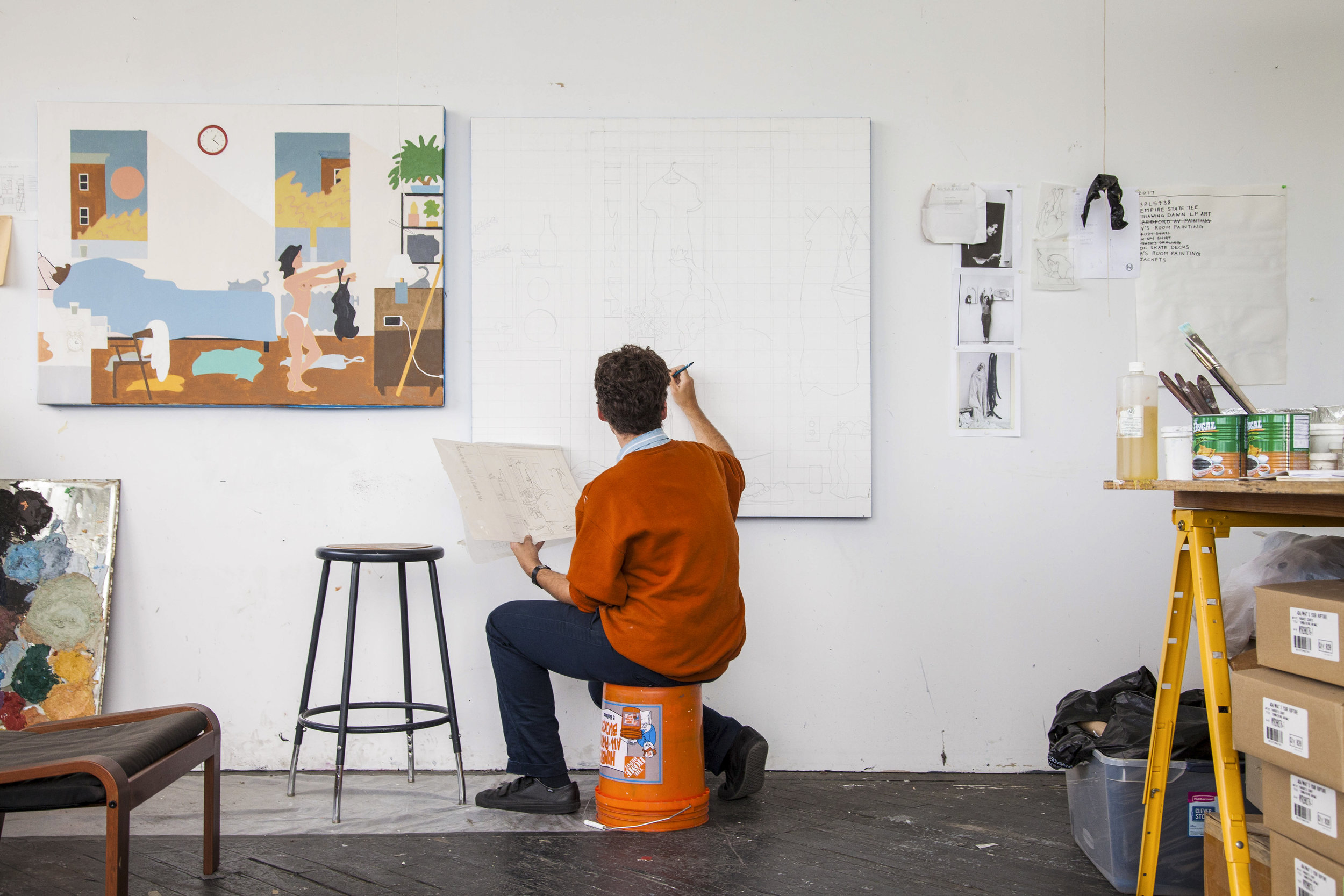
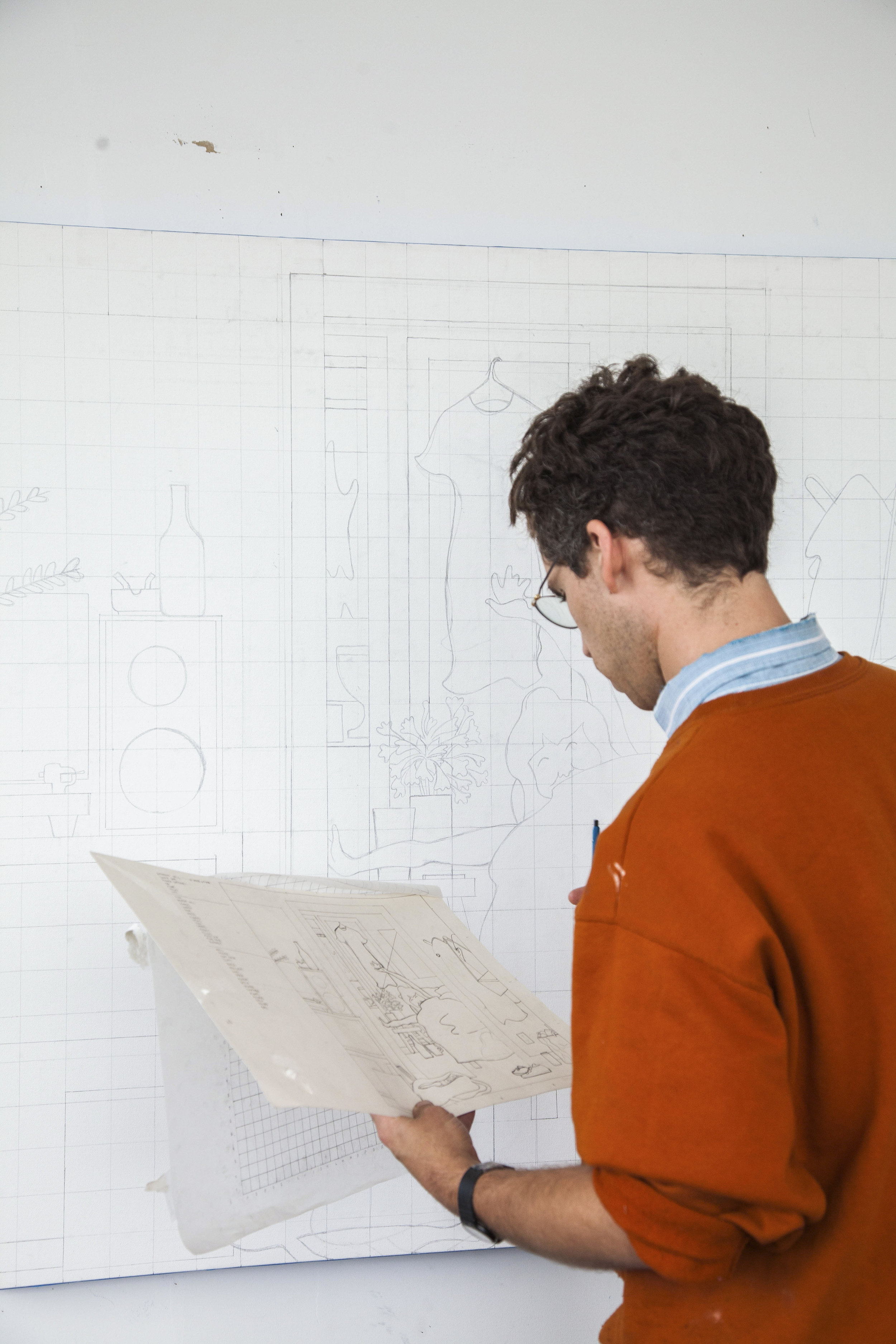
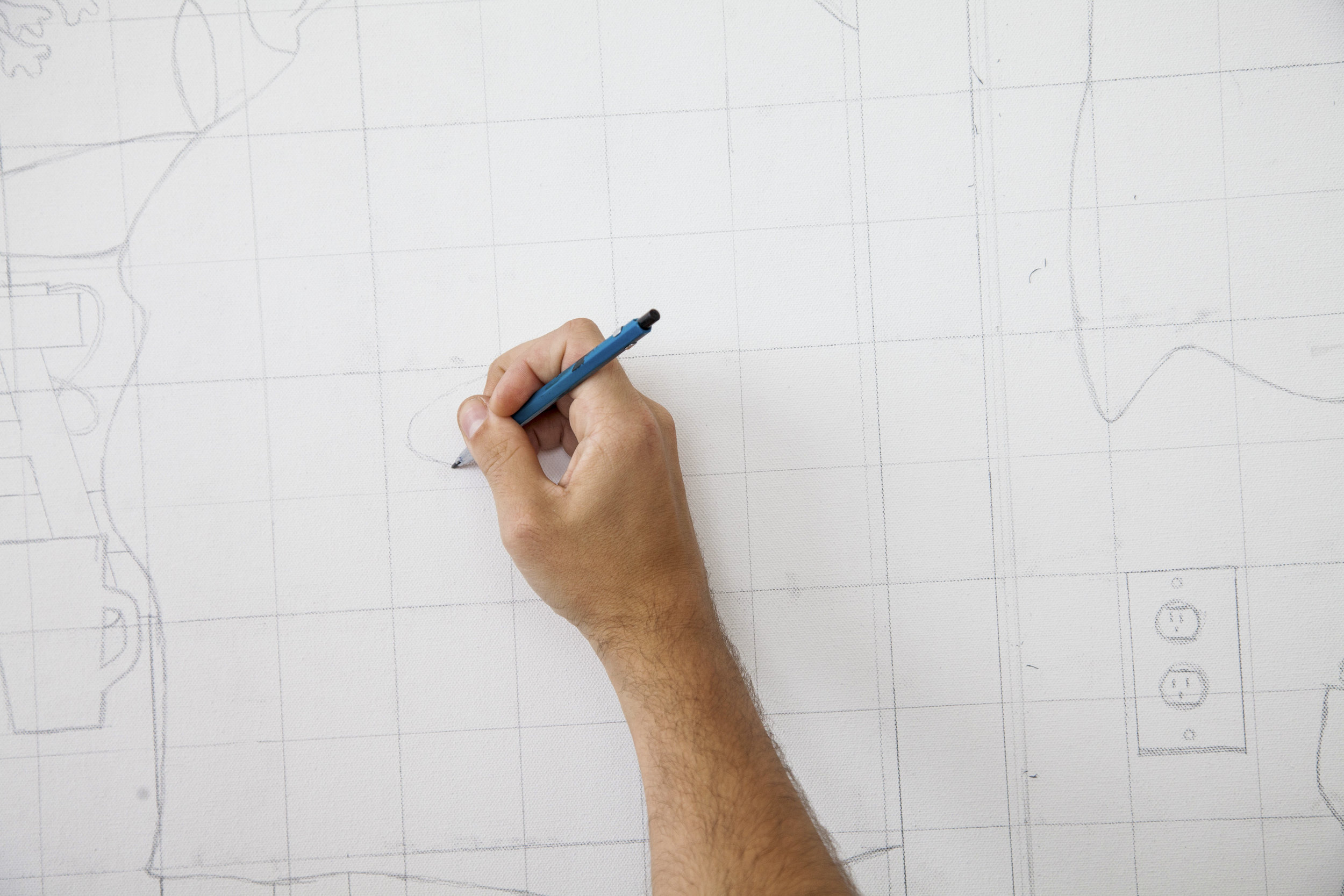
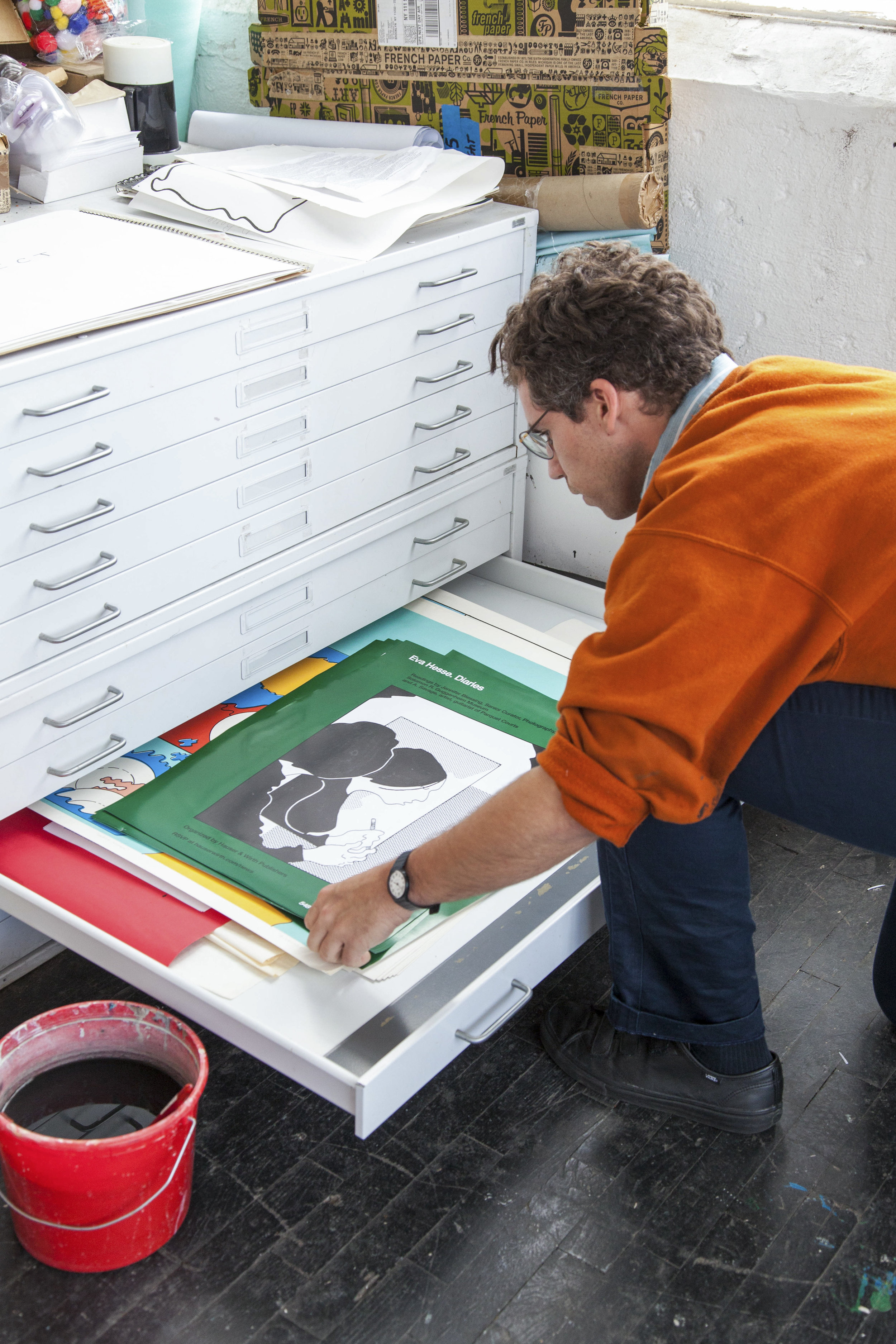
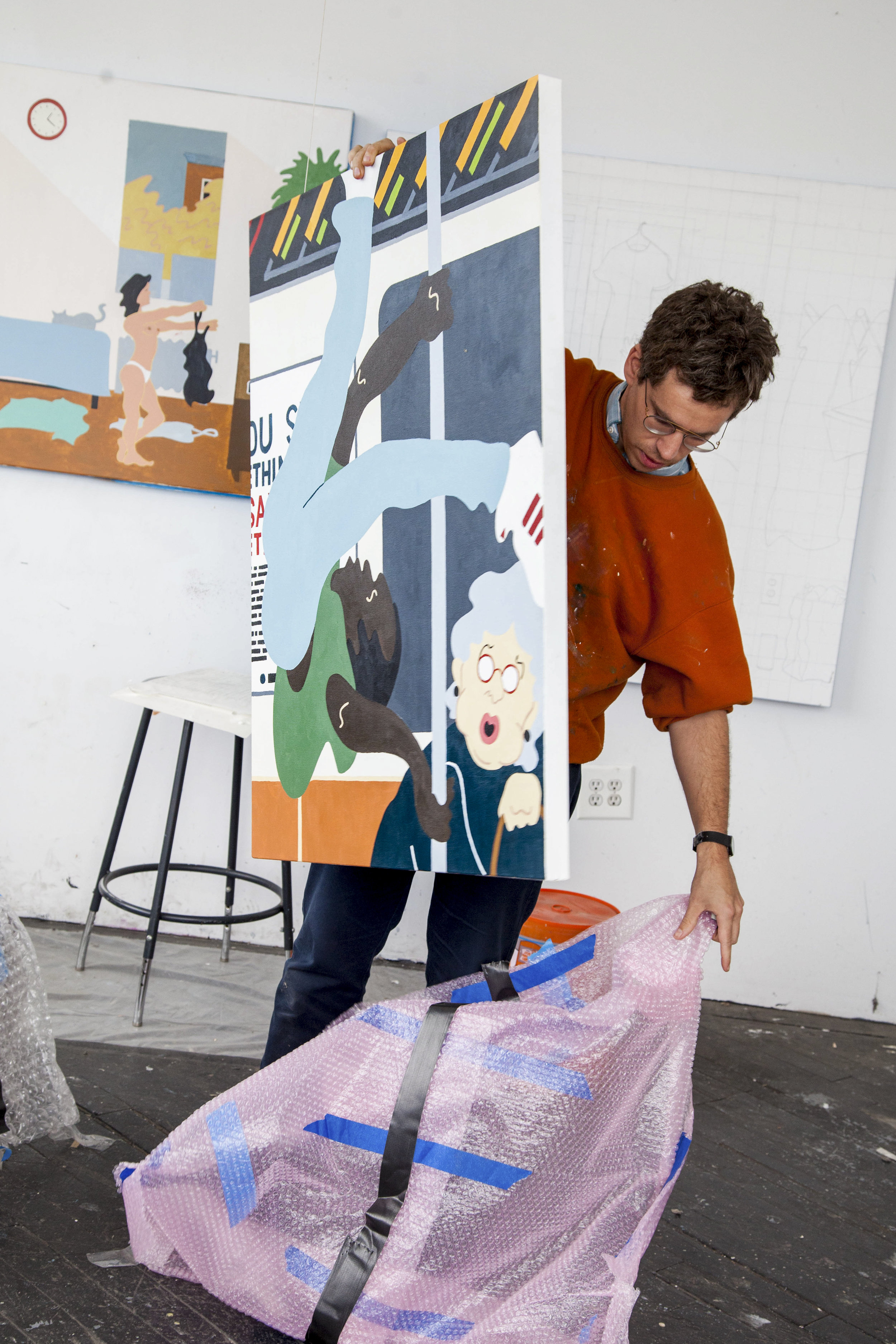
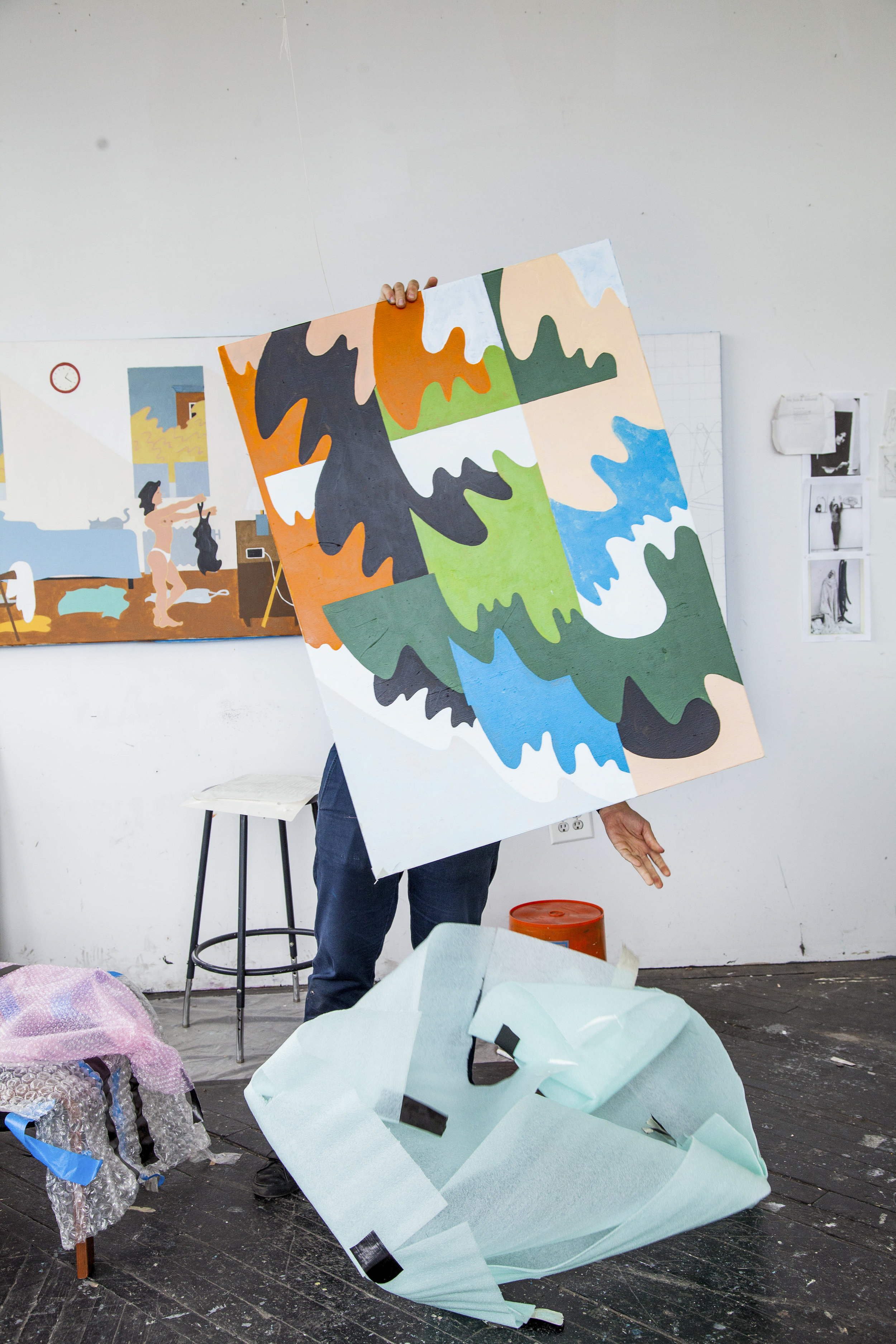
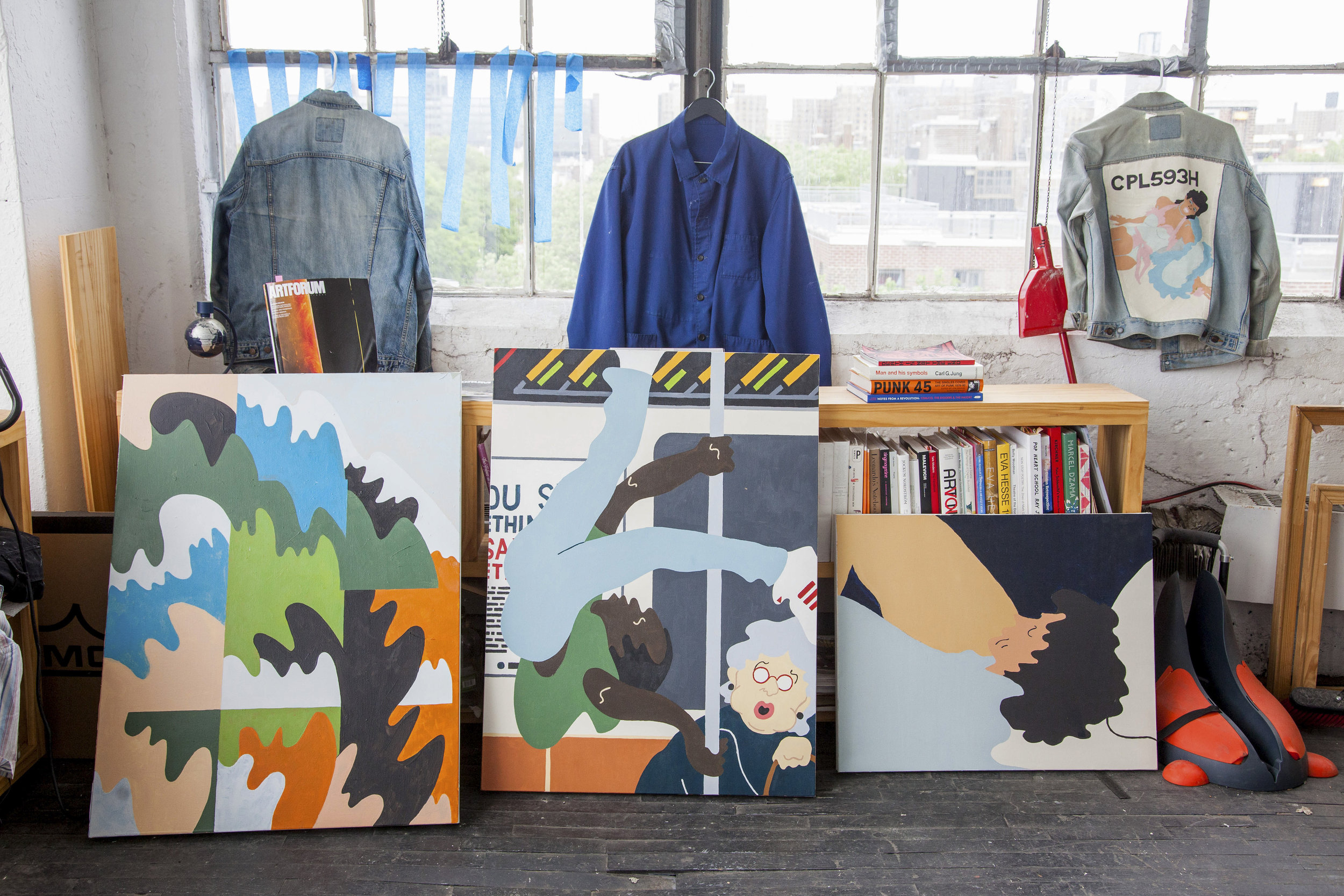
A. Savage
Who are you?
I am A. Savage.
What do you make?
Well I guess the short answer would be art, but within that there’s painting, which I do primarily, and drawing. I usually paint for painting’s sake, but I also do a lot of different things like album artwork for my band and some other bands. Commissions that I’ve gotten lately have been record artwork, t-shirts, and most recently a non music-based project that involves apparel. Aside from all that I’m a musician too. But it all sits somewhere on the spectrum of art for me; it’s all very interconnected. I have a kind of synesthetic relationship with sound and vision, which informs a lot of what I do. So naturally for whatever music projects I’m involved in, I look at them dually as visual art projects. To me visual art also has a relationship to sound in that often sounds, colors and numbers are synonymous. In visual things that I do, like painting, I think that there’s an element of sound being represented in color. The way that color is harmonized is much like the way that tone is harmonized. I would also say that the movement of sound is a quality that’s apparent in my lines.
Do you have a preferred medium?
I guess if I had any preferred medium it would be color. But as far as oil versus acrylic or ink versus paint, I use the one that’s most likely to execute my intention.
Describe your workspace.
I’m here in Bedstuy, right near South Williamsburg. It’s a large, dusty building. When I’m here it’s like the walls are the confines of my mind. It’s a place where I can really live in my own mind and not be distracted and not worry about making a mess. This is probably the most sacred place that I have in my life. I’d probably lose my apartment before I’d lose this spot. It’s also a good roosting point for the city. As long as you have windows like this, there’s always going to be a dialogue between you and the city.
Under what conditions do you work best?
I would say that the best condition for working is one that is prepared; by that I mean that your heart and mind are open to the possibility of inspiration. That’s a key thing for the creative process that took me a long time to learn – a big part of being able to receive inspiration is putting yourself in a situation where you’re prepared to receive it. Having this mental space of preparedness allows me to drop everything and pursue an idea once it has come; it means being able to push the rest of the world out. I guess that would be my answer: always being mentally in tune with and prepared for the possibility of inspiration.
A lot of times I work well in situations of stress, but not always. Not all of my work is related to stress. Sometimes art can be a mechanism for it; a cathartic thing or a purging thing. Other times it really helps to be at peace or at least push your stress outwards to be able to concentrate. So really there are a couple different ways I approach working. One would be submitting to the things at the top of my mind, and another would be trying to block them off for a moment to get tunnel vision of what I want to say in my work. Sometimes I’ll come up here and make a lot of work, but it will lack vision or intent, or sometimes concept. But that’s okay, because then I have something to show for my day. Maybe that perceived lack of context just hasn’t revealed itself yet – sometimes I’ll put something away and then take it out later, and the intent and idea that was subconscious ends up revealing itself. Patience can be a good condition for something like that.
Do you have any rituals surrounding your practice?
Smoking cigarettes, which is not the healthiest ritual. I’ve gotten into meditating recently, so I do that. I’ll either do it right when I wake up or when I first get here. That’s a new thing, but I think it has seen some good returns. For a long time I was put off by it because of its sort of new age applications, but I’ve since gotten over that. But I guess that being in the studio every day is kind of ritual in and of itself.
Describe your creative process.
I guess the creative process germinates with an idea. A lot of my work, specifically in painting, is very based in memory; I use only my mind and memory as an anchor for the images I make. I’ve got this series of bedroom interiors, all of which are places that I feel like I know intimately. What I want those pieces to show is the discrepancies between what our minds suggest reality to be and what reality is concretely. It’s funny to examine the things projected into the interiors versus what was actually there. We put so much meaning in objects and places because when we’re children everything is so saturated in meaning. Before we have language to construct around things, we have meaning for things. I think that’s something that the artist should never let go of, because meaning becomes more abstract once we’re socialized into reality as we know it. Tethering yourself to that childlike preoccupation with meaning is a good way to set yourself up for the creative process. If you keep things associated with their non-verbalized meaning, then you’re able to see them in a different way. So my own creative process has a lot to do with my relationship to the world, my environment and what I take in – these bedrooms being an example of what I remember and what I project into memory.
Describe your creation process.
The creation process is a bit different. The canvas that I’m working on now, for example, starts with a drawing. There are multiple sketches that came before the sketch that is there now; this drawing may be the fourth or fifth of its kind. Planning is the the most painstaking process; there’s a pretty large amount of planning that goes into the canvas. There’s a lot of tracing involved – I’ve got a light box – and a lot of gridding and drawing, and redrawing, elements. With stuff like the bedroom interiors, first I write down everything I remember about the space, and then I start to sketch those memories. Eventually I’m able to sketch them together into a drawing, and finally the paint comes out. At that point I feel like the tough part is done; I know what I’m doing, I know what I’m trying to say, I know what it’s supposed to look like. It then becomes a question of which colors will be flat and which colors will have texture. In a painting that I call Self Portrait in Seven Colors, you can see that some of the paint is flat and matte, while some of it is a bit noisier and has more texture or tooth to it. Those approaches come from different painters that I admire. Some painters work uniformly flat, some painters work in a – I hate this word – painterly way. In the latter case you can immediately recognize the paint as paint, whereas with someone like Jacob Lawrence or Picasso or even Matisse, they will do a lot of flat planes of color. I like a back and forth on the spectrum of things that are textural or flat.
I’m kind of an old school draftsman and I do a lot physically on paper of what my friends who are designers or web developers do almost entirely on a screen. I’m not extolling one over the other, I mean when I do any record for my band Parquet Courts I do my layouts in Illustrator and edit in Photoshop. But everything within that is drawn, everything is handwritten. That’s something that I don’t want to lose.
Do typography and handwriting play roles in your work?
Oh certainly, yeah. I’ve got a drawer full of handwritten liner notes from albums that I’ve worked on. I’m really drawn to text, as I think a lot of us in the city are. Sometimes I like to play with text as something that you see versus something that you read.
In what context do you hope for your work to be accessed?
Different works that I do have different applications. I’ve only had one solo painting show, but that’s a great context for painting to be observed as a body or work in that the paintings are communicating with and referencing each other. Also as someone who does art for music, I think a lot about my art being accessed as a tangible object in the form of a record. I hope that in that context the artwork can communicate the sound within a record. Or at least I hope there’s some curiosity about what the sound is based off of what you see on the record; ultimately it’s building an association of the sound with the visuals.
What do you hope your work communicates?
I tend to ask from art that it give me some sort of cerebral or emotional sensation or message – ideally both. I guess that’s what I’d like to give to an audience: what I see in art. I’d like for my art to be something that, if you kind of let it overwhelm you, stimulates the mind and the heart, and then puts you inside of it.
How have you learned what you know?
After college I worked for a company in Dumbo that dealt fine art posters – a lot of really old ones like the original Rauschenberg screen prints. It introduced me to a lot of artists that I hadn’t known or artists that they don’t teach you about in art history. We’d deal with posters from the Met, from Gagosian, from PS1. That was the best art education I ever had, but that could also be because I was more open to it, whereas in college maybe I was too immature to really open myself up to art history. But I guess that through figuring out what I admired in other artists and examining the way that their lines and colors spoke to me, I was able to apply their techniques to my own work.
I’ve also learned through just looking at art. For example, I admire Kandinsky for his use of color. He’s written extensively on it. Through his work and his writing, I’ve learned a lot about how to apply color in a way that makes it the content itself. His later work was largely non-representational, but his use of color was so well done that it didn’t need to be anchored in any sort of reality. I think that one of the greatest thrills of observing a work of art is trying to put your own meaning into it, drawing out what meaning the artist put into it, and finding how those two meanings communicate.
What is the most challenging part of your process? Where do you find the most ease?
Maybe the challenging part is figuring out what am I trying to say, since I can spend hours up here just drawing and making images and not knowing what I’m saying. It’s not entirely gratifying to be making something and not know the reason that you’re making it or what you’re trying to communicate. So I’d say that the most difficult part is finding that voice and making sure that the imagery isn’t arbitrary, that it has meaning, and that there is something to be gleaned from it. The hardest part about creating anything is that you have to meditate on something and know the ideas that you’re putting into it. I think that I’m most at ease once I’ve gotten past that step. Putting paint on the canvas is where the fun begins; at that point I know what I’m doing and I know exactly what I’m trying to say.
In what ways has your practice evolved over time?
My relationship to art has matured from when I was in my early twenties; I’ve become more critical and I’ve learned the virtues of restraint and limitations. Ultimately, putting constraints and limitations on yourself makes you speak a lot louder and it reveals a lot more about you and your intent. I think that a lot of stuff that I produced in art school was kind of lost. It had a superficial surface of imagery that was often really fanciful and whimsical, which is hard to think of critically. It wasn’t necessarily saying anything. Even in the art world, a lot of canonized stuff that relies on whimsy is hard for me to connect to. I have a hard time not seeing it on a superficial level. There was a turning point a few years ago when I became interested in not just the image alone but everything that I put into the image. Some people are lucky and have that perspective early, some people are geniuses that way, but I’m not one of them – all the better because it’s about the journey and process of finding your voice as an artist. The thing that came earlier to me was writing and making music.
Is there anyone or anything that inspires you?
Sure. I guess experience is a big inspiration. I have a hard time making work that is not rooted in experience. So inspiration is life itself, I suppose. As far as painters go, I’ve thrown out out Jacob Lawrence and Matisse and Picasso, I’ve thrown out Kandinsky. John Wesley is also big for me. Philip Guston is great with color. I found Eva Hesse inspiring as I became familiar with her through her diaries, which were not written for posterity. You get introduced to this side of her that is very different from her work, which had always struck me as being very confident and assertive and fully realized. But in fact she was very unconfident at times and was really hard on herself about her process and output. She was hard on herself about days when she made nothing, which I can relate to, and realizing stuff like that drew me closer to her art. So she’s someone who I admire more for the concepts than for the visual aspects of her art, which are undeniably beautiful. But ultimately I can appreciate and relate to her as someone who struggles with the creative process. I’ve got that same sort of relationship with Duchamp. Certainly there’s stuff of his that’s compelling to look at – Nude Descending a Staircase is one of my favorite paintings of all time – but then there’s stuff of his that is very conceptual and doesn’t necessarily stick with me. I admire that he was always willing to embrace something new and that he’s a very important figure associated with a lot of different movements and genres. So I admire him largely for being someone who’s very conceptually aggressive and malleable.
What has your practice taught you?
More than anything, probably patience. For people of our time there’s a certain kind of patience that we’ve forgotten because things are so accessible and instant. But in doing art, and especially in working with oil paint, you have to be patient and know that you are not going to turn a painting around in a week – it could take years. That’s hard to accept, because the world around you is moving so quickly while you’re moving relatively slowly. You have to resign to the fact that the world isn’t instantaneous although it may seem to be. If you’re going to produce something of quality, it does help if what you produce is thought out and if you spend a lot of time in dialogue with it. There are those beautiful moments of instant inspiration where something comes out almost immediately, but they’re very rare and shouldn’t be the standard that you set for yourself as an artist. So patience was taught to me as I realized that I don’t have to produce work at a rapid rate as long as I’m working through the process. Ultimately that’s going to show out in your work. In all the work that I admire – be it visual or musical – the process is very evident and patience is a big part of that.
How has your practice shaped your hands?
My hands? I don’t even want to say this out loud because I’m superstitious, but in a physical way, whenever I’m holding a brush or a pen for a long time, I feel the early stages of carpal tunnel. But beyond that, I mean they’re very callused, they’re not soft, they’re definitely the hands of someone who uses their hands a lot.
I could reemphasize what I was saying about the process going into a painting, because if you look at my work or any painter’s work, there should be no doubt as to what it is. Even when you look at a Mondrian, which is almost anti-painterly, or a Malevich, you see the brushstrokes in it, you see the canvas, and you see that at one time someone stapled that canvas onto the stretcher board. And where does that come from? It comes from the hand. The hand is what holds the brush, it’s what sketches the drawing, or in the case of liner notes the hand is what writes them. My liner notes may look like they could’ve been digitally done, but they’re not – what you see is what you get. I think that my hands are very apparent when someone looks at work like that, and I hope that patience and time are too.
A. Savage in Brooklyn, New York on May 26, 2017. Photographs by Krista Anna Lewis.
